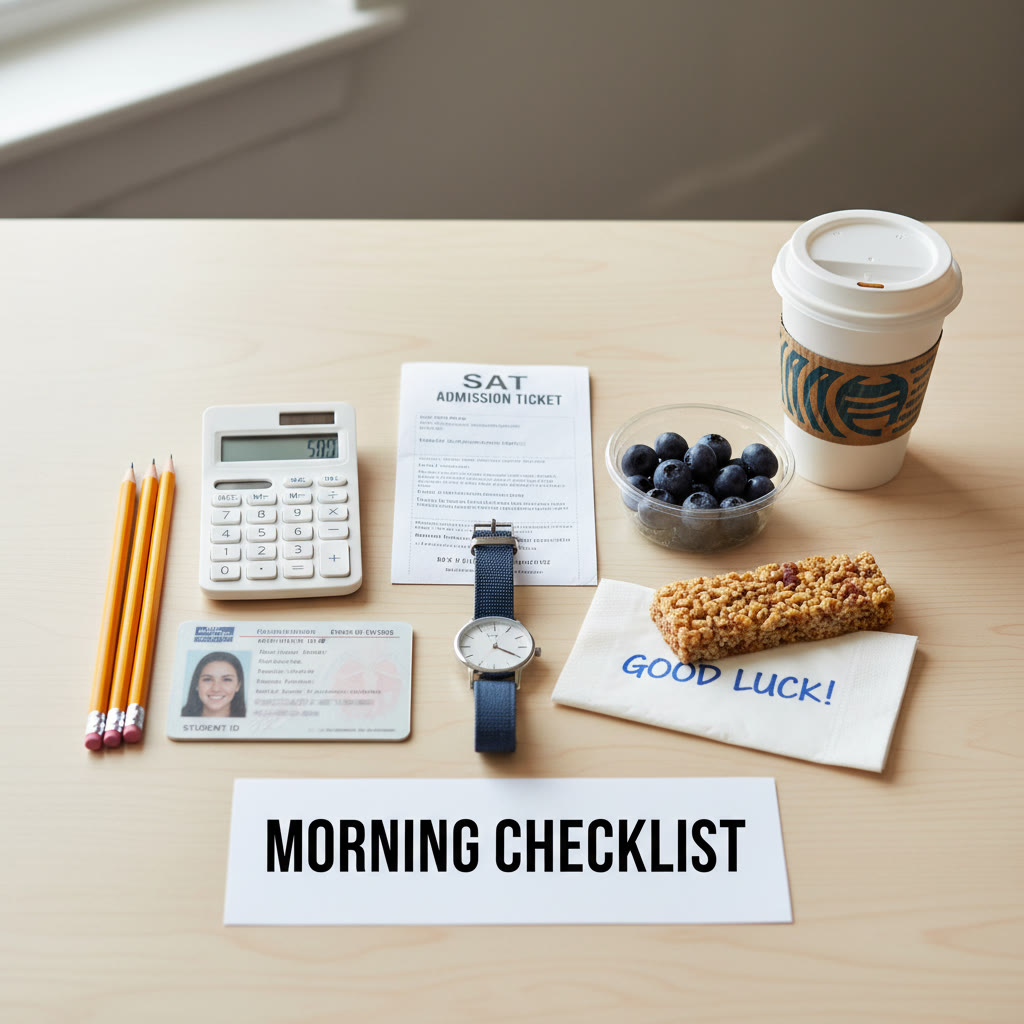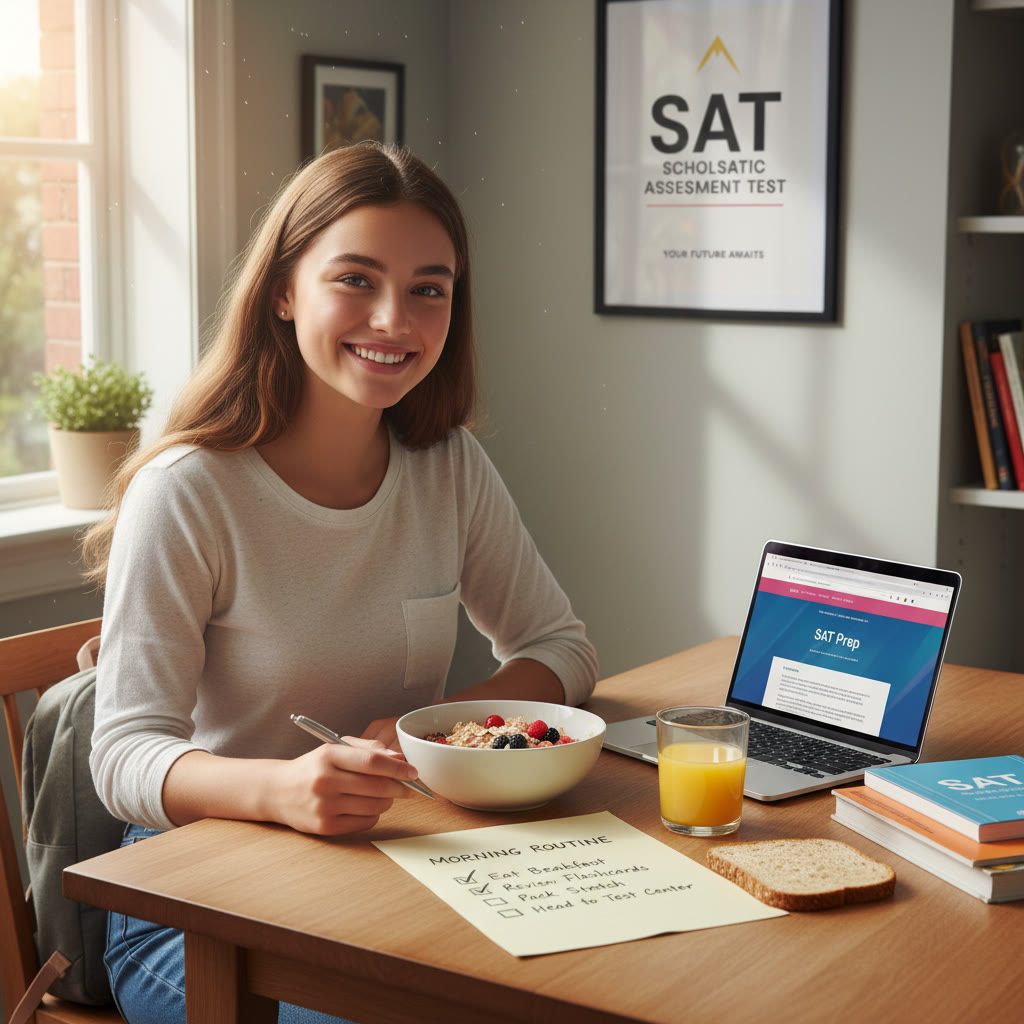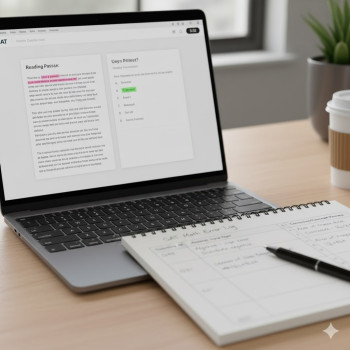Wake Up Calm: The Mindset That Starts Your Day Right
Test day morning isn’t a performance review — it’s a setup. You’ve done the work leading up to this day, and the goal now is simple: translate preparation into focused action. The difference between a shaky start and a calm, collected beginning is mostly habit. Breathe, move slowly, and treat the morning like you would the opening scene of something you’re confident about.
Two mantras to repeat
- “One step at a time.” You control the next hour, not the whole test.
- “I will do my best today.” That’s all any test asks for.
These are short, practical reminders you can replay while you tie your shoes or bite into your breakfast. Small rituals anchor your nervous system and shift you from scattered to steady.
Before You Leave the House: A Practical Checklist
Some things must be prepared the night before. On test day morning, you’re doing quick confirmations — not frantic searches.
Morning confirmation list
- Admission ticket / test name and reporting details (print or screenshot). Put it in your bag now.
- Acceptable photo ID (government-issued when possible; a school ID is sometimes accepted — know what your test center requires).
- Two No. 2 pencils with erasers (mechanical pencils are okay, but bring a couple of standard pencils).
- An approved calculator with fresh batteries and a calculator case. Turn it on now to confirm it works. Clear memory if you feel it’s needed.
- A watch without a wireless connection (check your test center policy; many places allow a simple analog or non-smart watch to manage time).
- A small snack for the break (banana, granola bar) and a bottle of water — put these in a closed bag so the proctors can inspect them.
- Layers of clothing — classrooms can run cool or warm; a lightweight sweater is a great choice.

If you’ve practiced with a single routine during your prep (same breakfast, same warm-up questions, same breathing), don’t change it now. Routines reduce decision fatigue and calm the impulse to cram.
Timing: When to Wake, Leave, and Arrive
Timing is both an operational need and a psychological anchor. Getting there early gives you buffer time to breathe and center. Here are concrete windows to aim for — adjust for your local start time.
Suggested timeline (assuming an 8:00 AM test start)
- Wake up: 5:30–6:00 AM. Give yourself at least 2–2.5 hours to wake up, eat, and go through your pre-test routine calmly.
- Leave home: 7:10–7:25 AM. Allow extra time for traffic, parking, or unexpected delays.
- Arrive at center: 7:30–7:40 AM. Aim to be there at least 30 minutes early to navigate check-in.
Arrival early also gives you time to use the restroom and settle into the room before the official start. Panic spikes when you feel rushed — slow everything down.
What to Eat and Drink: Fuel for Focus
Your brain runs on a steady stream of glucose. Think sustainable energy rather than a quick spike.
Smart breakfast choices
- Oatmeal with nuts or Greek yogurt with fruit — slow-release carbs plus protein.
- A whole-grain toast with peanut butter and a banana — quick, portable, and stabilizes blood sugar.
- An egg sandwich on whole grain — protein-rich and satisfying.
- Hydrate early: a glass of water when you wake up and another with breakfast. Sip slowly; don’t overdo caffeine if you’re jittery.
Avoid heavy, greasy foods that make you sluggish and avoid sugary drinks that can give a short-lived boost followed by a crash. If you’re used to coffee, a small cup is fine; if not, don’t start now.
Quick Mental Warm-Ups (What to Do — and What Not to Do)
The test morning is not the time for new strategies or long cram sessions. Short, targeted warm-ups can help the brain shift into test mode.
Five-minute warm-up ideas
- Do one or two questions from each section type that you’ve practiced a hundred times — nothing novel. These prime circuits you’ve trained.
- Spend three minutes doing deep-breathing exercises: inhale for 4, hold 4, exhale 6. Repeat four times.
- Recite one or two formulas or grammar rules you often use. Keep this list limited and practiced (not new).
- Visualize the first 10 minutes: walking into the room, sitting at your desk, opening the booklet calmly. This reduces surprises.
What not to do: long practice sections, learning new techniques, or checking score estimators. Those can raise anxiety and reduce clarity.
Section-by-Section Game Plan
Knowing the structure and realistic time per question is one of the best advantages you can bring into the room. Here’s a straightforward breakdown and tactical tips you can use on test day morning.
| Section | Time | Number of Questions | Average Time Per Question | Quick Strategy |
|---|---|---|---|---|
| Reading | 65 minutes | 52 | ~75 seconds | Passage mapping, read Qs selectively, refer back to passage for evidence |
| Writing & Language | 35 minutes | 44 | ~48 seconds | Focus on concision, grammar patterns, and sentence context |
| Math — No Calculator | 25 minutes | 20 | ~75 seconds | Use algebraic shortcuts, mental math, skip hard items to save time |
| Math — Calculator | 55 minutes | 38 | ~87 seconds | Use calculator smartly, plug in answers, cross-check tricky algebra |
Note: The test runs roughly three hours of testing with a single 10-minute break — plan your internal pacing around that rhythm. If you’re using a watch, set simple check-in times before the first few sections so you can gauge whether you’re on pace.
Reading: Keep a Passage Map
- Spend the first 20–30 seconds scanning the passage for structure: topic sentence, tone shifts, examples, conclusions.
- Use the question stems to target passages. If a question asks for a specific line reference, go there and read the surrounding 1–2 sentences.
- Don’t aim to memorize details; look for main idea and author intent. Mark lines in the booklet and annotate with short ticks or arrows.
Writing & Language: Look for the Why
- When a sentence revision is offered, ask: “Why change this?” Is it clarity, concision, grammar, or tone?
- Watch for commonly tested grammar patterns: subject-verb agreement, parallel structure, comma usage with clauses, pronoun clarity.
- If two answer choices both sound correct, choose the one that is most direct and specific — that’s usually preferred.
Math: Strategy over Speed
- Do the easy problems first. In both math sections, there are always lower-value questions that you can score quickly.
- If stuck, plug in simple numbers or use answer choices backwards — these tricks save time and reduce algebraic errors.
- For no-calculator problems, write down one or two quick steps to avoid mental slips; don’t rely solely on head math under stress.
On test day morning, rehearse in your head the idea of “mark and return.” If a question is chewing up time, mark it, move on, and come back during a sweep.
Bubble Sheet Strategy
Filling in the answer sheet is more than a mechanical step — it’s a small time-management decision. Here are two common approaches and how to decide which to use on test day morning.
Options for bubbling
- Bubble as you go: Minimizes the risk of misaligning answers if you panic at the end. Slightly more time-consuming in the moment.
- Mark the booklet and bubble during natural lulls or the break: Allows faster reading, but if you miscount or lose track, it’s risky.
If you typically lose focus when switching tasks, bubble as you go. If you’re efficient at transfers and want to focus purely on reading or solving, mark and bubble later. Whatever strategy you choose, practice it during full-length practice tests — that’s the only way you’ll know what’s realistic for you.
Break Time: Use It Wisely
There’s a short break in the middle of the test (usually 10 minutes). Think of it as a mini-reset — not a study session.
Good break activities
- Eat a light snack and hydrate.
- Use the restroom and stretch briefly — loosen your shoulders and neck.
- Practice 60 seconds of deep breathing or a quick grounding exercise: look around and name five things you can see, four things you can touch, three you can hear.
Avoid checking your phone or talking about specific problems from the first half of the test. That can increase anxiety and distract you from the second half.
Tactics for Anxiety and Focus
Nerves are normal. The goal is to manage them, not eliminate them. Small habits keep your mind clear and your body steady.
On-the-spot calming techniques
- Box breathing: inhale 4, hold 4, exhale 4, hold 4. Repeat two to three times.
- Progressive muscle relaxation: tense and release shoulders, jaw, hands for 10 seconds each.
- Micro-pauses: after every passage or math set, close your eyes for three seconds and take a slow, steady breath.
These tiny resets cost very little time and protect you from spiraling when you hit a hard question. Also, remind yourself that the SAT rewards steady performance over bursts of brilliance: a calm mind is strategic and fast.
Practical Problem-Solving Habits
What you do the first time you read a question matters. Here are habits to make automatic in the morning and in the test room.
- Underline exactly what the question asks — for example, “main purpose” versus “author’s attitude” are different targets.
- When stuck on a math problem, try a simple test value to check answer choices quickly.
- Eliminate clearly wrong choices first. Two wrong answers are a small victory that makes the right one more visible.
- Use the margin: quick sketches, labeling variables, and small calculations keep you organized.
What to Avoid on Test Day Morning
Good morning routines are about doing the right things and avoiding the wrong ones. Here are a few things to skip.
- No last-minute cramming or brand-new strategies. Your brain needs calm, not new rules.
- Don’t over-caffeinate — excess caffeine can make you jittery and interfere with focus.
- Avoid discussing specific question content with other test-takers during the break; it can make you doubt correct instincts.
- Don’t forget to double-check your ID and materials before you walk out the door.
Practical Examples: How These Tips Play Out
Two short scenarios to show how the morning routine actually helps on test day.
Scenario 1: Emma — the steady starter
Emma wakes up at 5:30, eats oatmeal with almonds, and does a two-minute breathing exercise. She arrives 35 minutes early, uses the restroom, and sits quietly reviewing one page of formulas she’s practiced. During the test she bubbles as she goes, marks hard questions, takes the 10-minute break to stretch and eat half her granola bar, and finishes the test with time to re-check quick calculations. Her morning routine helped her avoid panic when she hit an unexpectedly dense reading passage.
Scenario 2: Jamal — the strategic improver
Jamal is prone to rushing, so he rehearsed a specific pace with his tutor and Sparkl’s personalized tutoring sessions: short timing drills and simulated morning checklists. On test morning he wakes early, runs through a quick 5-minute mixed practice set, and leaves with his pre-packed bag. He opts to mark in his booklet during reading and bubbles during breaks because he knows that switching tasks reduces his accuracy. That small, practiced decision saved him time on later sections.
These stories show the power of tiny habits practiced ahead of time. That’s where targeted, 1-on-1 guidance and tailored study plans — like those offered through Sparkl’s personalized tutoring — can make a real difference: they help you rehearse the right routines until they feel automatic.
After the Test: Quick Post-Test Habits
Once the last bubble is filled, don’t obsess about every answer. Your post-test energy is better spent on recovery and reflection, not immediate score-guessing.
Immediate post-test checklist
- Celebrate small wins: you showed up, you focused, you finished.
- Record quick impressions: which sections felt strong, which were unexpectedly tough — keep this for later review.
- Give yourself a tangible reward: lunch with a friend, a walk, or a favorite treat.
In the days after the test, if you plan to retake it, review your test experience with a calm, analytical approach: look for patterns, not single-question regrets. Targeted tutoring or AI-driven insights from a program like Sparkl can help you turn that analysis into a short, effective plan for improvement.
Final Words: Confidence Is a Routine
Test day morning is a small window where calm choices compound into clear performance. You don’t need perfection — you need practice. Build a repeatable sequence: the same breakfast, the same warm-up, the same bathroom routine, the same approach to stubborn questions. Practice it in every full-length test so it feels automatic.
When the date arrives, your job is simple: follow your plan, manage your energy, and be kind to yourself. You’ve trained; now let your routine do the heavy lifting.
If you want help rehearsing a personalized morning routine, timing strategies, or anxiety-management techniques, consider working with a tutor who can tailor a plan to your habits and strengths. Personalized, expert guidance — especially when it includes 1-on-1 coaching and data-driven feedback — makes test mornings feel familiar rather than intimidating.

Good luck. Walk in with calm, act with focus, and leave proud of the effort you gave. The SAT is a single snapshot — but how you prepare for that snapshot can transform your performance. Make the morning count.















No Comments
Leave a comment Cancel